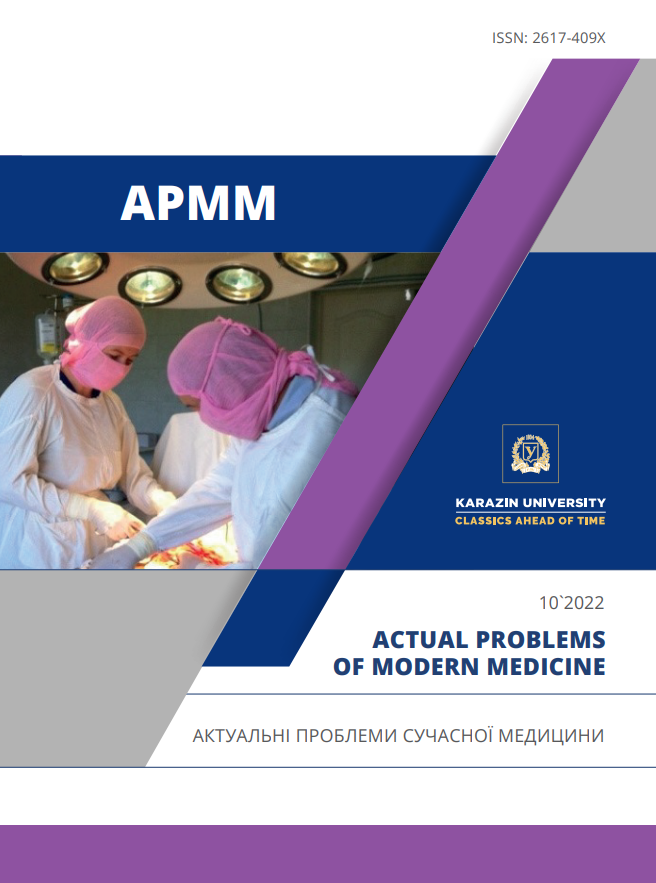Prognostic value of left ventricular global longitudinal strain in patients with hypertrophic cardiomyopathy
Abstract
ABSTRACT. Hypertrophic cardiomyopathy (HCM) is one of the widespread genetically determined diseases of the myocardium, which is accompanied by the development of diastolic and, subsequently, systolic dysfunction of the myocardium. The aim of our study was to evaluate the clinical and instrumental features of patients with hypertrophic cardiomyopathy with impaired left ventricular global longitudinal strain (GLS) and its prognostic value for the development of cardiovascular events in the Ukrainian population of patients with hypertrophic cardiomyopathy. Materials and methods. The data of 35 patients with hypertrophic cardiomyopathy who underwent a comprehensive clinical and instrumental examination with determination of the absolute global longitudinal strain on speckle-tracking echocardiography were retrospectively analyzed. The patients were divided into two groups: Group I (GLS< 14.5) and Group II (GLS≥ 14.5). Results. A decrease in global longitudinal strain was associated with a longer disease duration (8 (5-11) vs 3 (2-5) years, p=0.003), increasing of complaints on irregularity of heart beat (66.7% vs 23.5%, p= 0.018) and weakness (61.1% vs 23.5%, p=0.04), increased systolic blood pressure (SBP) (130 (120-140) vs 110 (100-120) mm Hg, p= 0.009), the absence of patients without signs of heart failure (0 vs 29.4%, p=0.019), an increase in IVRT (106.19±28.62 vs 84.57±27.54 ms, p=0.044) and a greater number of ventricular extrasystoles (17 (4-69) vs 2 (0.5-3), p=0.014). According to the Kaplan-Meier analysis of survival in relation to fatal and non-fatal cardiovascular events or their combination with hospitalization for heart failure, they had significantly worse survival rates (Log-Rank, p=0.016 and p=0.003). Conclusions. Hypertrophic cardiomyopathy patients with poor global longitudinal strain scores were characterized by worse clinical and instrumental data and an unfavorable cardiovascular prognosis.
Downloads
References
Authors/Task Force members; Elliott PM, Anastasakis A, Borger MA, Borggrefe M, Cecchi F, Charron P, et al. 2014 ESC Guidelines on diagnosis and management of hypertrophic cardiomyopathy: the Task Force for the Diagnosis and Management of Hypertrophic Cardiomyopathy of the European Society of Cardiology (ESC). Eur Heart J. 2014 Oct 14;35(39):2733-79. DOI: https://doi.org/10.1093/eurheartj/ehu284
Maron BJ, Gardin JM, Flack JM, Gidding SS, Kurosaki TT, Bild DE. Prevalence of hypertrophic cardiomyopathy in a general population of young adults. Echocardiographic analysis of 4111 subjects in the CARDIA Study. Coronary Artery Risk Development in (Young) Adults. Circulation. 1995 Aug 15;92(4):785-9. DOI: https://doi.org/10.1161/01.cir.92.4.785
Varma PK, Neema PK. Hypertrophic cardiomyopathy: part 1 - introduction, pathology and pathophysiology. Ann Card Anaesth. 2014 Apr-Jun;17(2):118-24. DOI: https://doi.org/10.4103/0971-9784.129841
Ommen SR, Mital S, Burke MA, Day SM, Deswal A, Elliott P, et al. 2020 AHA/ACC Guideline for the Diagnosis and Treatment of Patients With Hypertrophic Cardiomyopathy: A Report of the American College of Cardiology/American Heart Association Joint Committee on Clinical Practice Guidelines. Circulation. 2020 Dec 22;142(25):e558-e631. DOI: https://doi.org/10.1161/CIR.0000000000000937
Maron BJ. Clinical Course and Management of Hypertrophic Cardiomyopathy. N Engl J Med. 2018 Aug 16;379(7):655-668. DOI: https://doi.org/10.1056/NEJMra1710575
Nesukai EH, Adarychev VV, Tytov EIu, Hyresh YY. Apykalnaia hypertrofycheskaia kardyomyopatyia. Klynycheskyi sluchai y obzor lyteraturы. Artery-alnaia hypertenzyia; 2017;1.51:60-71. DOI: https://doi.org/10.22141/2224-1485.1.51.2017.96251 [in Ukrainian]
Tseluiko VY, Kynoshenko KIu, Myshchuk NE. Otsenka deformatsyy myokarda levoho zheludochka v klyny-cheskoi praktyke. Liky Ukrainy 2014; 9(185): 52-56. [in Ukrainian]
Trembovetskaia EM, Knыshov HV, Zakharova VP. Pro-dolnoe sehmentarnoe smeshchenye stenok levoho zhe-ludochka u bolnыkh hypertrofycheskoi kar-dyomyopatyei. Ukraynskyi kardyolohycheskyi zhur-nal, 2015, 1: 81-85. Dostupno na :http://journal.ukrcardio.org/wp-content/uploads/2015/01/9_1_2015.pdf
Tseluyko VYo, Butko OO, Konstantin YuK. Prognostic Value of Different Electrocardiographic Patterns in Hypertrophic Cardiomyopathy Patients. EC Cardiology 2022;9.7:04-17. Available from: https://ecronicon.org/assets/eccy/pdf/ECCY-09-00897.pdf
de la Rosa A, Shah M, Shiota T, Siegel R, Rader F. Comparing echocardiographic characteristics in genotype positive-phenotype positive hypertrophic cardiomyopathy and hypertensive left ventricular hypertrophy. Eur Heart J Cardiovasc Imaging. 2022 Feb 22;23(3):340-348. DOI: https://doi.org/10.1093/ehjci/jeab217. PMID: 34694376
Baudry G, Mansencal N, Reynaud A, Richard P, Dubourg O, Komajda M, et al. Global and regional echocardiographic strain to assess the early phase of hypertrophic cardiomyopathy due to sarcomeric mutations. Eur Heart J Cardiovasc Imaging. 2020 Mar 1;21(3):291-298. DOI: https://doi.org/10.1093/ehjci/jez084. PMID: 31056691
Van Velzen HG, Schinkel AFL, van Grootel RWJ, van Slegtenhorst MA, van der Velden J, Strachinaru M, et al. Five-year prognostic significance of global longitudinal strain in individuals with a hypertrophic cardiomyopathy gene mutation without hypertrophic changes. Neth Heart J. 2019;27(3):117-126. DOI: https://doi.org/10.1007/s12471-019-1226-5
Tower-Rader A, Mohananey D, To A, Lever HM, Popovic ZB, Desai MY. Prognostic Value of Global Longitudinal Strain in Hypertrophic Cardiomyopathy: A Systematic Review of Existing Literature. JACC Cardiovasc Imaging. 2019;12(10):1930-1942. DOI: https://doi.org/10.1016/j.jcmg.2018.07.016
Yang Y, Wu D, Wang H, Wang Y. Prognostic value of global longitudinal strain in hypertrophic cardiomyopathy: A systematic review and meta-analysis. Clin Cardiol. 2022;45(12):1184-1191. DOI: https://doi.org/10.1002/clc.23928
Reant P, Mirabel M, Lloyd G, Peyrou J, Lopez Ayala JM, Dickie S, et al. Global longitudinal strain is associated with heart failure outcomes in hypertrophic cardiomyopathy. Heart. 2016 May 15;102(10):741-7. DOI: https://doi.org/10.1136/heartjnl-2015-308576
Lee HJ, Kim HK, Lee SC, Kim J, Park JB, Hwang IC, et al. Supplementary role of left ventricular global longitudinal strain for predicting sudden cardiac death in hypertrophic cardiomyopathy. Eur Heart J Cardiovasc Imaging. 2022;23(8):1108-1116. DOI: https://doi.org/10.1093/ehjci/jeab187
Haland TF, Almaas VM, Hasselberg NE, Saberniak J, Leren IS, Hopp E, et al. Strain echocardiography is related to fibrosis and ventricular arrhythmias in hypertrophic cardiomyopathy. Eur Heart J Cardiovasc Imaging. 2016;17(6):613-21. DOI: https://doi.org/10.1093/ehjci/jew005
Gil TCP, Castier MB, Gondar AFP, Sales AF, Santos MO, Lima FCDS, et al. Strain Analysis of Left Ventricular Function in the Association of Hypertrophic Cardiomyopathy and Systemic Arterial Hypertension. Arq Bras Cardiol. 2019 Sep 2;113(4):677-684. DOI: https://doi.org/10.5935/abc.20190176




